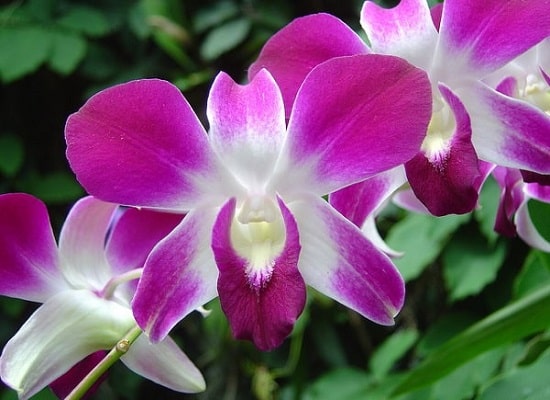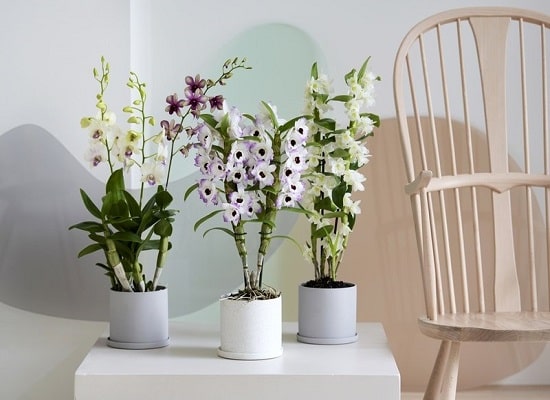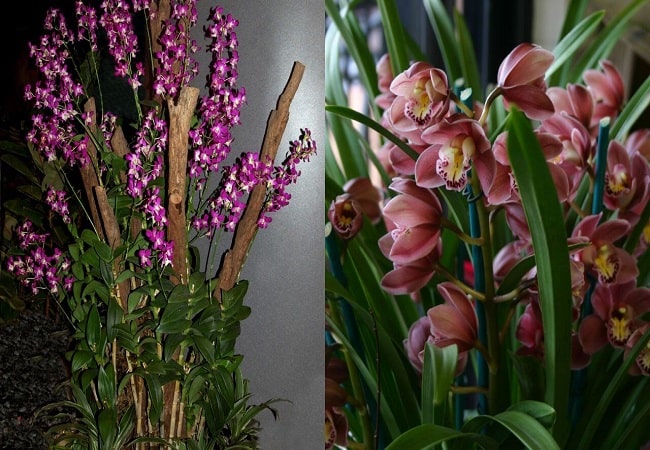Orchids are a diverse and fascinating group of plants that come in various shapes, sizes, and colors. Two popular orchids are dendrobium orchid vs Cymbidium orchid, which have unique characteristics and growing requirements.
This article will discuss the differences between Dendrobium and Cymbidium orchids, such as their history, where they came from, how they look, and how to care for and grow them. By the end of this article, readers will know the main differences between these two types of orchids and be able to decide which one might be best for their garden or home.
The main points I will cover in this article include the history and origin, physical characteristics, and care and cultivation requirements of Dendrobium and Cymbidium orchids, as well as a comparison of the two types and their key differences.
Quick Navigation
- 1 History And Origin Of Dendrobium Orchids
- 2 Physical Characteristics Of Dendrobium Orchids
- 3 Care And Cultivation Of Dendrobium Orchids
- 4 Dendrobium Orchid Vs Cymbidium Orchid
- 5 Physical Characteristics Of Cymbidium Orchids
- 6 Care And Cultivation Of Cymbidium Orchids
- 7 Comparison Of Dendrobium And Cymbidium Orchids
- 8 In Summary,
- 9 Frequent Requested Information
History And Origin Of Dendrobium Orchids

Dendrobium orchids are native to many regions, including Southeast Asia, the Pacific Islands, Australia, and South America. They are found in various habitats, including rainforests, grasslands, and rocky cliffs.
Westerners discovered the first Dendrobium orchids in the early 19th century, and quickly became popular among collectors and horticulturists. Dendrobium orchids were brought to Europe and North America, where they became widely popular as ornamental plants.
In some cultures, Dendrobium orchids are seen as symbols of beauty and elegance. They are often used in traditional medicine and as natural remedies. In some Asian cultures, Dendrobium orchids are associated with good luck and prosperity.
Physical Characteristics Of Dendrobium Orchids

Dendrobium orchids are known for their elongated, slender stems and delicate, narrow leaves. The size of Dendrobium orchids can vary greatly, with some species reaching over a meter in height and others remaining small and compact.
Dendrobium orchids are renowned for their bright colors, which include red, pink, purple, yellow, and white. Some Dendrobium species have flowers that are just one color, while others have flowers with patterns or markings.
One notable characteristic of Dendrobium orchids is their ability to produce new growth and flowers from their old, woody canes. This allows them to bloom repeatedly over a long period.
Among the many different species of Dendrobium orchids, there are variations in the size, shape, and color of the flowers, as well as differences in the size and appearance of the plant itself. Some Dendrobium species are more suitable for growing in pots. In contrast, others are better suited for growing in baskets or on slabs of wood.
Care And Cultivation Of Dendrobium Orchids

Dendrobium orchids prefer bright, indirect light and high humidity and thrive in temperatures ranging from 65-85 degrees Fahrenheit. It is essential to provide good air circulation around the plants to prevent problems with pests and diseases.
Dendrobium orchids are hard to water because they tend to rot if they get too much water or die if they get too little. A good rule of thumb is to water the plants when the top inch of the potting mix feels dry to the touch and to let the potting mix dry out a little between waterings.
Dendrobium orchids benefit from regular fertilization, but it is essential to use a balanced fertilizer formulated specifically for orchids. Fertilize the plants every two weeks during the active growing season, and reduce fertilization during the dormant season.
Common problems that may arise when growing Dendrobium orchids include pests such as mealybugs and aphids and rot or fungal diseases. Keeping the plants clean and inspecting them regularly is vital to prevent problems. To avoid corrosion and fungal infections, it is crucial to provide good drainage and to avoid over-watering the plants.
Dendrobium Orchid Vs Cymbidium Orchid
Cymbidium orchids are a group of epiphytic orchids native to Asia, Australia, and the Pacific Islands. They are known for their large, waxy flowers and distinctive, leathery leaves.
Cymbidium orchids have a long history of cultivation in their native regions, where they have been used for medicinal purposes and as a source of perfume. They have also been used in traditional Chinese medicine to treat various ailments.
Cymbidium orchids were first introduced to Western society in the early 19th century and have since become popular among orchid enthusiasts and collectors due to their beautiful flowers and ability to thrive in a wide range of climates.
Cymbidium orchids are associated with elegance and refinement in some cultures. They are often used in floral arrangements and as corsages. They are also often given as gifts to celebrate special occasions.
Physical Characteristics Of Cymbidium Orchids
Cymbidium orchids are known for their large, waxy flowers, which come in various colors, including white, yellow, pink, red, and green. The flowers are typically held on long, upright stems and have a delicate, refined appearance.
Cymbidium orchids have thick, leathery leaves that are typically a deep green. The plants are generally extensive, with some species reaching over three feet in height.
One notable characteristic of Cymbidium orchids is their ability to flower repeatedly over a long period. Some Cymbidium species are known to produce multiple spikes of flowers per season. In contrast, others may only make a single spike.
Among the different species of Cymbidium orchids, there are variations in the size, shape, and color of the flowers, as well as differences in the size and appearance of the plant itself. Some Cymbidium species are more suitable for growing in pots. In contrast, others are better suited for growing in baskets or on slabs of wood.
Care And Cultivation Of Cymbidium Orchids
Cymbidium orchids prefer bright, indirect light and high humidity and thrive in temperatures ranging from 60-80 degrees Fahrenheit. It is essential to provide good air circulation around the plants to prevent problems with pests and diseases.
Watering Cymbidium orchids are challenging since they decompose if overwatered. Still, they can also suffer if left to dry out entirely. Water the plants until the top inch of the potting mix feels dry to the touch, and let the potting mix dry some between waterings.
Cymbidium orchids do better when fertilized regularly, but you must use a balanced fertilizer made for orchids. Fertilize the plants every two weeks when they are actively growing and less often when not growing.
When growing Cymbidium orchids, you may encounter problems with pests like mealybugs and aphids and issues with rot or fungal diseases. To keep pests away, it’s essential to keep the plants clean and check on them often. Make sure plants have good drainage, and don’t give them too much water to keep them from getting rot and fungal infections.
Comparison Of Dendrobium And Cymbidium Orchids
| Common Name | Dendrobium orchid | Cymbidium orchid, boat orchid |
| Botanical Name | Dendrobium spp. | Cymbidium |
| Plant Type | Perennial | Evergreen flower |
| Mature Size | 6-48″ height, 6-48″ width | Around 2 feet tall |
| Sun Exposure | Partial | Partial |
| Soil Type | Moist but well-drained | Loamy, moist, well-draining |
| Bloom Time | Spring, summer, and fall | Mid-autumn to mid-spring |
| Soil pH | Acidic | 5.5 to 6.5 |
| Flower Color | White, yellow, orange, green, pink, purple, brown | Pink, green, yellow, and white |
| Hardiness Zones | 9–12 (USDA) | 10 to 12 |
Orchids are some of the most beautiful and varied flowers, with over 25,000 species identified. Two of the most popular types of orchids are Dendrobium and Cymbidium orchids. Compare the two types of orchids below,
- One key difference between Dendrobium and Cymbidium orchids is the size and appearance of the plants. Dendrobium orchids tend to be smaller and more compact, with slender stems and delicate leaves. In contrast, Cymbidium orchids are giant and have thicker, leathery leaves.
- Another difference between the two types of orchids is the appearance of the flowers. Dendrobium orchids have a wide range of flower colors and patterns. In contrast, Cymbidium orchids are known for their large, waxy flowers in various colors.
- Regarding care and cultivation, Dendrobium and Cymbidium orchids have similar light, temperature, and humidity requirements. However, Dendrobium orchids are known to be more forgiving of neglect. They are easier to grow, making them a good choice for beginner orchid growers. Cymbidium orchids, on the other hand, can be more challenging to grow and may require more attention and care.
- One notable similarity between Dendrobium and Cymbidium orchids is their ability to produce new growth and flowers from old, woody canes, allowing them to bloom repeatedly over a long period. Both orchids are known for their long-lasting flowers and ability to thrive in various climates.
In Summary,
Dendrobium and Cymbidium are famous and beautiful orchids with several differences and similarities. Dendrobium orchids are more miniature, compact plants with a wide range of flower colors and patterns. In contrast, Cymbidium orchids are larger plants with thick, leathery leaves and large, waxy flowers in various colors. Both types of orchids have similar care and cultivation requirements. Still, Dendrobium orchids are known to be more forgiving of neglect. They are easier to grow, making them a good choice for beginner orchid growers.
Suppose you’re interested in growing either Dendrobium or Cymbidium orchids. In that case, it’s essential to research the specific care and cultivation requirements of the particular species you choose and any potential problems and solutions. With proper care and attention, both Dendrobium and Cymbidium orchids can thrive and provide a beautiful and long-lasting display of flowers.
Frequent Requested Information
How Do I Identify A Cymbidium Orchid?
To identify a Cymbidium orchid, you can look for the following characteristics:
- Leaf Shape: Cymbidium orchids have long, narrow leaves that are typically dark green.
- Flower Size and Shape: Cymbidium orchids have large, showy flowers, typically about 5-10 cm (2-4 inches) in diameter. The flowers are generally bell-shaped, with a narrow base and flared petals.
- Flower Color: Cymbidium orchids are known for their bright, bold flower colors, ranging from white and yellow to pink and red.
- Flower Arrangement: Cymbidium orchids typically have several flowers on a single stem, arranged in a spiral pattern.
- Location: Cymbidium orchids are native to temperate and subtropical regions of Asia and Australia, so if you see an orchid growing in these regions, it is more likely to be a Cymbidium orchid.
How Do You Identify Dendrobium?
Dendrobium is a large and diverse genus of orchids native to tropical and subtropical regions of Asia, Australia, and the Pacific Islands. There are over 1,500 species of Dendrobium orchids, so it can be challenging to identify a specific species without expert knowledge. However, a few general characteristics are common to most Dendrobium orchids:
- Stem And Leaf Shape: Dendrobium orchids typically have thin, upright stems with narrow, linear leaves. The leaves may be extended, thin, shorter, and more rounded, depending on the species.
- Flower Size And Shape: Dendrobium orchids have small to medium-sized flowers, typically about 2-5 cm (1-2 inches) in diameter. Flowers can be found in many colors, including white, yellow, pink, purple, and red. The flowers are typically bell-shaped, with a narrow base and flared petals.
- Flower Arrangement: Dendrobium orchids typically have several flowers on a single stem, arranged in a spiral pattern. Some species may have a single flower per stem, while others may have clusters of several flowers.
- Location: Dendrobium orchids are native to tropical and subtropical regions of Asia, Australia, and the Pacific Islands, so if you see an orchid growing in these regions, it is more likely to be a Dendrobium orchid.
How Long Do Dendrobium Orchids Last?
The lifespan of a Dendrobium orchid can vary depending on several factors, including the care it receives, the environment in which it is grown, and the specific species of Dendrobium. Dendrobium orchids are known for their long-lasting flowers, which can remain in bloom for several weeks to several months.
It is essential to provide the proper care to help your Dendrobium orchid last as long as possible. Here are a few tips:
- Watering: Water your Dendrobium orchid regularly, but be sure not to overwater it. The soil should be kept moist but not soggy.
- Fertilizing: Use a balanced fertilizer to provide your Dendrobium orchid with the nutrients it needs to grow and bloom. Follow the manufacturer’s instructions for the appropriate amount and frequency of fertilization.
- Light: Dendrobium orchids prefer bright, indirect light. Avoid placing them in direct sunlight, which can scorch the leaves and flowers.
- Temperature: Dendrobium orchids prefer a warm, humid environment. Keep the temperature between 60-80°F (16-27°C) and provide plenty of moisture in the air to help prevent the flowers from drying out.

My name is Md Robiul Islam and I’m a plant enthusiast. I like to have a garden and research different plants. I also have an interest in environmental science and would like to work in that field in the future.


